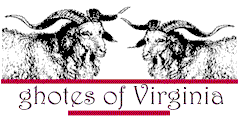
Hungars Church
Adapted from "The History of Hungars Episcopal Church, Hungars Parish, Northampton County,
Bridgetown, Virginia" by Anne Floyed Upshur & Wilsom M. Stitt. Undated pamphlet.
NOTE: The authenticity of this account has been called into question.
A better account can be found at http://www.hungarschurch.com/.
In 1645, will made by Richard Vaughan bequeathed Tobacco "Toward the building of a house
for God's service." Records not long after this time indicate punishments being inflicted at the
"time of divine service" at Nuswattocks Church. Court Records indicate that the Nuswattocks
Church became known as Hungars in 1661.
The Church stood about 150 yards North of Pear Plain house, on the West bank of the Creek,
near the Tavern of Walter Williams. Some old Sycamore trees, usually associated with Colonial
Church boundaries, are still growing on this spot. In 1654, Stephen Charlton left his 1500 acre
farm on Church Neck to the parish, if his daughter, Bridget, had no heirs. When Bridget died
childless in 1704, the farm became the property of the parish, its yield to go toward the support of
the rector, providing "that he preach once every Lords daye; and oftener if required," and that
there "should be no vancancye of such a Minister in this parrish by the space of six months." The
parish used the farm for a glebe for over a century. The August 12, 1803, Norfolk Herald carried
an ad for a minister for Hungars Parish, offering the use of a 1600 acre Glebe and 12 servants.
The Glebe was taken away from the parish by the county in 1853, after many years of court
battle.
THE SECOND CHURCH
Court Records of July 9, 1679, tell us that an agreement was made between the Hungars Church
Wardens and Symon Thomas to build the second Hungars Church. Part of the materials were to
come from the old church building--implying that the First Church was no longer usable. The
agreement reads: "40' x 20' x 10' on posts. Posts, braces, studs, rafters and purlongs of oak, and
locust blocks under the Church. To frame and cover the outside with plank. To have arches
underneath the roof, and to ceil the Church with the ceiling from the Old Church. If not enough
ceiling, the Parish will furnish more, also nails and diet for the builder and his aides; and the keep
of a hand able to work with an axe for one month." The agreed upon price for the construction
was 10,000 pounds of Tobacco and Casks.
One year later this Church is mentioned when Major William Spencer gave an acre of ground
"whereon the frame of a Church now stands." In 1691, the Upper and Lower Parishes were
united, and from that time on the whole Parish was known as Hungars.
In 1709, William Byrd wrote in his diary "I went to Hungars Church where there was the largest
congregation I ever saw in the country." Thomas Dell, rector of Hungars Parish in 1764, reported
to the Bishop of London that the Parish held two churches and that Holy Communion was
celebrated six times a year. The average number of Communicants was 80 in the parish,
recounted Dell, who catechised in the Summer months. He further lamented that no "Ornaments"
were provided, and the churches lacked nearly everything. Dell's salary was 16,000 pounds of
tobacco, worth 55 Pounds Sterling. Dell further noted that the vestry cared for the Glebe, there
were no public schools, and that of the 365 families, "scarce one third of them" attended church
services.
THE THIRD (AND PRESENT) CHURCH
No record has been found of the erection of the third--and present--Hungars Church. However,
an entry in the minutes of the Assembly of Virginia for July 19, 1742, concerns the disposition of
pews in "the New Church" in Hungars Parish. Again, the present Communion Service is in
scribed "the gift of the Honorable John Custis, Esquire, of Williamsburg, to the Upper Church of
Hungars Parish in Northampton County, 1742." Hence, this date is taken for the building of the
New Church. Tradition says that Southey Satchel built Hungars Church.
In the Court Records is this entry: May 14, 1752, Thomas Presan, for the "consideration of a pew
in the brick Church called Hungars, marked T. P. 1751" exchanged one acre of ground "whereon
Hungars Church now stands, and adjoining to an acre given by William Spencer."
Hungars Church was the longest and next to the largest colonial Church of rectangular form of
whose completion there is any record in Virginia, being ninety feet by forty feet, inside, with
walls two feet thick. Its furnishings in colonial times were extremely rich, the chancel being hung
with dark crimson velvet draperies of superb quality, edged with bullion gold braid, all imported
from England. Its worship was enhanced by a pipe organ, one of the earliest in the country.
After the Revolutionary War and the disestablishment of the Episcopal Church, from 1782 to
1819, many colonial church buildings in Virginia were abandoned and Hungars Church was
largely unused. By the close of this period, it had been completely stripped of its rich furnishings.
The Church was restored to service in 1819, the old building having been repaired at a cost of
$1400.00. Bishop Moore consecrated it in May, 1821. According to the history of the Church
prepared by Anne Floyd Upshur & Wilson M. Stitt, "the roof was shingled in 1837, and seats
were built under the West gallery for the accommodation of colored people."
In 1840 the congregation yielded to the spirit of change, and destroyed most of the remaining
colonial features of the church's interior. The original center aisle was replaced by two side
aisles, and the paneled box pews, which were large and nearly square, with narrow seats on three
sides, were torn out and modern pews installed. The high colonial pulpit, which stood at the
north side of the church, near the side door, was moved to the chancel, from which it has since
disappeared. The wooden floor of the pews was extended over the chancel and the former center
aisle.
By 1850 the church was considered unsafe. In March, 1851, the vestry resolved to replace it with
a new building, using as much of the old buildings materials as possible. Thomas F. Stevenson,
a contractor of Snow Hill, Maryland, however, offered to save the building by shortening it,
closing the side doors, and putting two doors in the west end instead of the one originally there.
He also salvaged the doors to use again. He was more interested in doing honest work than
making a profit: as a shingle bearing a signed statement that he had lost $100 on the job came to
light when the 1851 roof was repaired a few years ago.
It is thought that the original church had a barrel ceiling. The altar canopy was once enclosed for
use as a vesting room. The present interior was made in 1892 when the partition under the gallery
was installed, stove flues built, and the North vesting room was enclosed. In 1922 a new oak
floor was laid over the old pine floor. New cypress shingles were put on the roof.
In 1950 a number of modifications were made in the church. Lighting and central heating were
installed, and the South vesting room was enclosed, necessitating a change in the stairway. A
small electric water system was added adjacent to the North vesting room. A brick floor was laid
in the Vestibule, the interior of the church repainted, and handsome new carpets installed in
1955.
In 1959 the parish house was built on the Southwest portion of the church grounds, near the site
of the second Hungars church building. It was consecrated by the Rt. Rev. George P. Gunn in
1960.
Return to the top of this page
Return to the Parish House Cookbook Recipes page
Return to the Eastern Shore History index page
Return to the GHOTES home page
 >>> Advertise Here <<<
>>> Advertise Here <<<